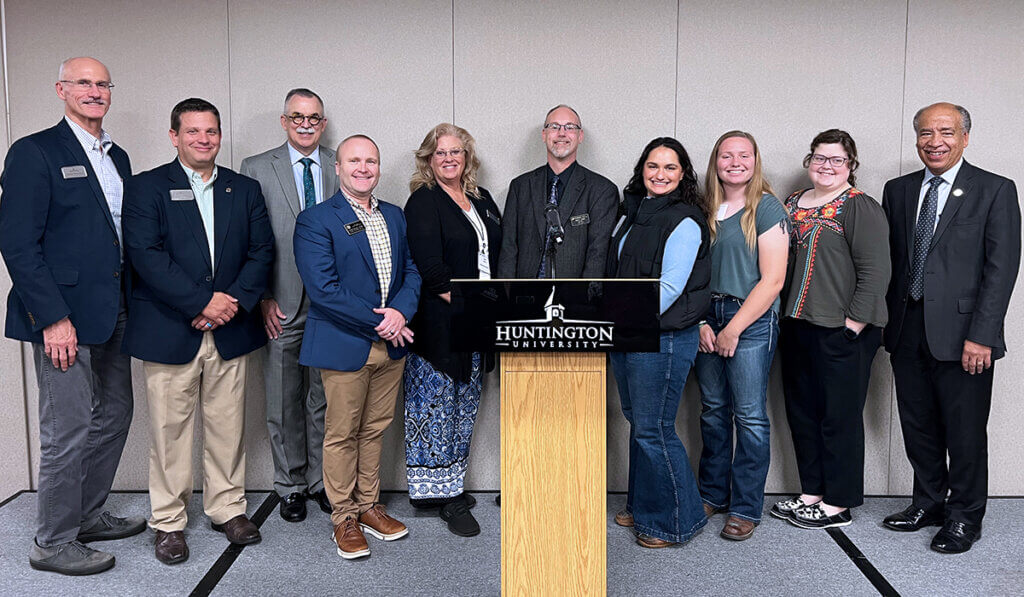
Representatives of the Purdue University College of Veterinary Medicine took a road trip across the state earlier this month to spotlight the college’s role in addressing the pressing issue of a shortage of veterinary nurses (veterinary technicians). Through a series of evening events in Evansville, Indianapolis, Valparaiso, and Huntington during the first week of October, Dr. Chad Brown, director of Purdue Veterinary Nursing Programs, presented a talk entitled, “Addressing the Indiana Registered Veterinary Technician Shortage Through Distance Learning.”
Dr. Brown provided background information about the shortage, citing references that forecast growth of more than 20 percent in the employment of veterinary technologists and technicians between 2022 and 2032, with an anticipated 14,800 job openings each year. In contrast, the 224 AVMA CVTEA-accredited programs nationwide, coupled with ten distance learning/online formats, produce only about 5,760 qualified graduates annually. Dr. Brown pointed out that efficient veterinary practices are known to maintain a nearly three-to-one ratio of veterinary technicians and assistants to veterinarians. He added that it’s actually beneficial to have an even closer ratio of veterinary technicians to veterinarians on a team, with the optimal ratio being at least two registered veterinary technicians (RVTs) to every one DVM.
Dr. Brown further pointed out that Indiana’s ratio is just under 1.4 RVTs for every one DVM, (2,530 RVTs compared to 1,820 DVMs), which lags behind the rest of the country. To achieve the optimal 2:1 ratio, Indiana would need an extra 1,110 veterinary technicians. Considering that annually, only 100-120 RVT students graduate from Indiana’s three on-campus programs, it would take approximately 16 years to overcome the difference.
Noting that enrollment at traditional educational institutions is constrained by limited physical space, Dr. Brown emphasized that online veterinary nursing (veterinary technology) degree programs present a promising alternative. These digital platforms offer increased flexibility and can accommodate many more students, regardless of where the students live. Dr. Brown explained that consequently, online learning holds the potential to boost the RVT graduation rate considerably, making distance education a pivotal strategy for rectifying Indiana’s RVT shortage in the near term.
Dr. Brown also shared that it is crucial to improve understanding within the veterinary profession about the key role RVTs play in helping to shoulder the veterinarians’ workload. “According to the Indiana State Scope of Practice law (IC 25-28.1-4-3), RVTs are authorized to carry out a vast array of duties in a clinic, contingent upon their training, expertise, and abilities,” Dr. Brown said. “By empowering RVTs to work at the height of their capabilities, we not only optimize the care provided to our clients, but also alleviate some of the pressures faced by veterinarians, enriching the overall practice environment.”
Dr. Brown then described Purdue’s Veterinary Nursing Distance Learning program (VNDL). With more than 830 active students, 120 of whom are Indiana residents, the program illustrates the promise that distance learning holds for bridging the gap in the veterinary nursing workforce. Dr. Brown then offered an illustration to show how veterinary practices can utilize Purdue’s VNDL program to make a tangible impact on the veterinary nursing workforce. “When clinic owners or managers participate in a minor tuition sharing program with veterinary assistants, they make a significant contribution to the future of their practice,” Dr. Brown said. “In the right arrangement, the result is a skilled veterinary nurse who can elevate the practice and be retained as a dedicated employee.”
Dr. Brown added that after a student graduates, passes the Veterinary Technician National Exam (VTNE), and becomes credentialed as a veterinary technician, the practice stands to also benefit financially. He cited a study by the AVMA Veterinary Economics Division’s assistant director of economics Frederic Ouedraogo, which was presented at the AVMA Economic Summit in 2019, that showed how adding a credentialed veterinary technician to the practice staff and utilizing them to the fullest extent of the practice act, could boost revenue by more than 18 percent.
Following Dr. Brown’s presentation, Purdue VNDL program assistant director Josh Clark, MS, RVT, highlighted ongoing instructional design upgrades that are being made to the distance learning program modules to enhance the overall student experience. “With these improvements, we observe higher retention and success rates amongst our students,” Mr. Clark said. “They are more likely to remain engaged in the program and graduate on time.” He went on to say that graduates of the distance learning program outperform the national average on the VTNE, which is the exam graduates take to secure their RVT certification and demonstrate their readiness to enter the workforce as an RVT.
The evening concluded with a presentation by Purdue Veterinary Medicine’s chief development officer, Tanya Finkbiner, who described opportunities for practices to collaborate with the college during the VNDL redesign process. With a minimal financial commitment, practices and individuals can sponsor a didactic course in the program, giving them visibility with students who will be entering the workforce as graduates in the future.
The last stop of the VNDL roadshow was at Huntington University (HU), where PVM Dean Willie Reed, Dr. Brown, and Mr. Clark got the chance to meet with the university’s leadership and some of the 11 students who are taking part in a newly created dual degree program between HU and Purdue Veterinary Medicine. For the past 18 months, HU and Purdue’s Veterinary Nursing program have been forging the dual degree initiative. This innovative program enables students to attend in-person classes at HU and partake in online courses through Purdue University’s VNDL program. The comprehensive four-year plan utilizes Purdue’s esteemed VDNL curriculum and Huntington University’s faith-based coursework in agriculture and animal well-being to give the students the opportunity to earn two degrees simultaneously: a bachelor’s in animal health from Huntington University and an associate’s in veterinary nursing from Purdue University.
